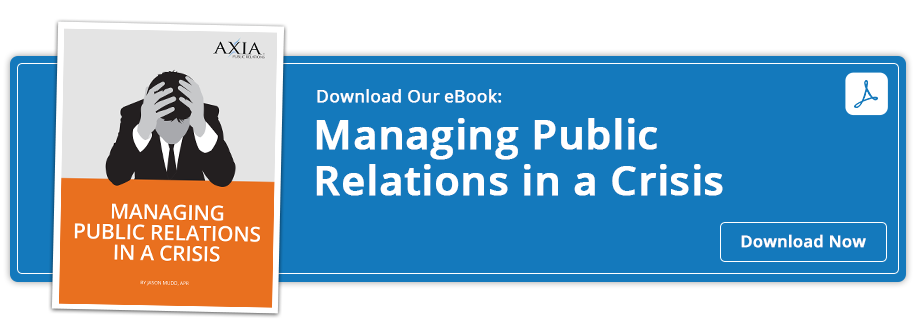 A crisis can happen to any business and the results can be devastating. Even something seemingly insignificant, like an off-the-cuff remark by a CEO or other top executive, can snowball into a major public relations nightmare. When it happens to your company, what can you do?
A crisis can happen to any business and the results can be devastating. Even something seemingly insignificant, like an off-the-cuff remark by a CEO or other top executive, can snowball into a major public relations nightmare. When it happens to your company, what can you do?
Here is a checklist your business can use to ensure you handle the problem in the most effective way.
- Evaluate your brand strength.
What was the public’s perception of your brand before the incident? If there was a high level of goodwill, you can use that in your upcoming statements. If there have been repeated incidents that have made the public question your company, you have a tall mountain to climb, but you can still get ahead of the issue.
- Research the incident.
Your PR team must be careful that they have all of the facts and are clear on the public’s perception of the incident. What actually happened? But also, what does it look like happened?
- State your story.
Choosing the right words to convey your message is crucial. Be simple, not slick. Deliver an honest, believable message. Keep the story uniform across all outlets. Most people begin to believe a message after hearing it an average of six times.
- Timing is everything.
Sometimes, the desire to get out in front of a story quickly overcomes the logic behind knowing what you are going to say. Look at the big picture, the calendar of events, what the media is doing – all before you release a statement or hold a press conference to try to manage damage control.
- Prepare the backup plan.
The media may take the story in a different direction. Plan for all likely scenarios that could ensue. Your profit and perhaps your boss’s job depend on it.
Here are two mini case studies of companies that used the checklist at different times in the process:
- Whole Foods overpricing (slow to use the checklist).
The business had a strong brand, yet knew of the quips referencing the public’s alternate name for the store – Whole Paycheck. When the story broke about the store’s significant overpricing, it tried to stick with its same old story and not implement the crisis communication steps. It didn’t work. The company used the checklist after its attempts to manhandle the media didn’t work.
Whole Foods eventually conquered the news, but at the expense of profit margin and customer trust. And people still call them by the unflattering nickname.
- Bud Light advertising slogan failure (fast to use the checklist).
Last year, Anheuser-Busch labeled some of its bottles with the slogan “The perfect beer for removing ‘no’ from your vocabulary for the night” to tie into its “Up For Whatever” ad campaign. The move caused swift backlash among consumers, who criticized the company for being incredibly irresponsible in allowing a tagline that seemed to promote reckless drinking – and worse, rape culture. The company issued an official apology within two days of market delivery. Taking an exceptional step, the senior director of U.S. marketing communications personally responded to hundreds of Tweets, thus putting a senior staffer directly in the line of fire of the public. And by doing so, she repaired the brand reputation.
Anheuser-Busch spent a lot of money in what turned out to be a failed campaign, but it saved the brand from more damage and erosion of goodwill – and actually, most consumers forget this even happened.
Defaulting to the truth shows a commitment to your brand, but mishandling the crisis may mean you will need to rebuild your customer base. A PR firm can strengthen your brand and build your reputation to help protect your company in the event of a crisis. Axia Public Relations offers more information and tools for crisis management in its e-book Managing Public Relations in a Crisis. Download your guide today to learn the best practices to guard your business.

 Heather M. Hilliard is a marketing and strategic planning professional with expertise in crisis management communications. With two master’s degrees and her international Certified Emergency Manager credential, she has worked through disasters as well as “normal business” for large- and small-scale events in a variety of industries. She is an adjunct professor at Tulane University and currently focuses on strategic communications and improvements for clients.
Heather M. Hilliard is a marketing and strategic planning professional with expertise in crisis management communications. With two master’s degrees and her international Certified Emergency Manager credential, she has worked through disasters as well as “normal business” for large- and small-scale events in a variety of industries. She is an adjunct professor at Tulane University and currently focuses on strategic communications and improvements for clients.
Topics: public relations, reputation management, crisis communications

Comment on This Article